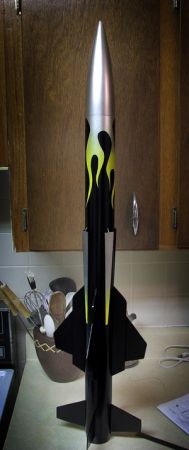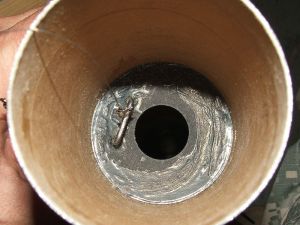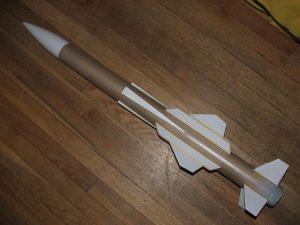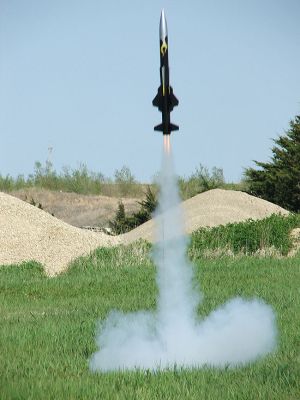| Construction Rating: | starstarstarstarstar_border |
| Flight Rating: | starstarstarstarstar_border |
| Overall Rating: | starstarstarstarstar_border |
| Length: | 39.25 inches |
| Manufacturer: | The Launch Pad  |
| Style: | Cluster |
Brief:
A Launch Pad original, the Scimitar is a two motor cluster, mid power rocket. Some skill in model rocket building is
needed for this kit but overall it is a very easy kit to build.
Construction:
The parts list:
- Two Body Tubes
- 24mm Motor Tubes and Retainers
- Couplers
- Cardboard Centering Rings and Bulkhead
- Plastic Nose Cone
- Balsa For Fins
- Mylar Parachute
- Elastic Shock Cord
- Fin Templates
- Cardstock Transition and Scoops
This kit came with detailed instructions and should be followed to the letter if you are wanting the same performance that TLP advertises. Overall, the instructions are easy to follow. They do not include CP or CG locations or where to place the launch lugs, but this is an advanced kit and you should be able to determine those things for yourself anyways.
The kit goes together very well as long as you make sure to plan out all of your fins on the balsa before you cut them. They include just enough balsa to make the fins, but if you plan the cuts wrong you will run out before you are done. The balsa is also very soft and the instructions state you are to apply CA to the fins for strength. I decided to paper the fins with cardstock and wood glue instead. If you do this, make sure you book the fins over night so they do not curl up on you.
The motor mounts are recessed in the back of the transition pretty far so I decided to add some material to strengthen that area and protect it from the motors. I cut some thin tin flashing I bought at Home Depot to the appropriate size and glued it in place with JB Weld. So far the addition of the flashing has payed off. You can clearly see the char from the motors on the tin but no damage to the rocket.
The recovery system relies on the old Estes three fold paper method, which I think would work just fine in this model, but I decided to change it up just a bit to suit me. TLP includes a bulkhead that mounts up front in the body tube making a parachute compartment. I think this is a great idea and it helps keep the CG where it needs to be and also baffles the ejection charge some. What I did was back the cardboard bulkhead with balsa and epoxy in place a U-bolt that I made myself out of a coat hanger and attached a steel leader to that. I then attached about eight foot of thick elastic then what comes in the kit to the end of the leader. This gave me something that I can pack above the wadding to keep from getting it burnt, and the elastic is also easily replaceable.
One thing to mention, if you build this rocket stock then the parachute included is more than enough needed, but if you add the mods that I did you will break a fin almost every time it lands. Invest in a bigger chute for it if you do decide to bulk it up.
The kit also includes some cardstock parts, such as the rear transition and the ducts that are on the side of the rocket. The instructions call for soaking the parts in CA, which gives them more than enough strength. Bending them may be a bit tricky, but the effects are well worth it. All said and done this is a very satisfying rocket to build and fly.
Finishing:
The kit does not come with any decals, but it does come with sort of a painting diagram. This was such a cool looking
rocket that I decided to DX the military theme and go with a nice sporty flame job. I filled the spirals and joints
with wood filler and sanded and primed the entire rocket. I painted the entire rocket gloss black and then after it
dried I masked off the flames and painted them metallic silver fading to yellow. I also painted the ducts on the side
of the body silver and yellow which produced a very nice accent. I then clear coated the entire rocket to finish it
off.
All paints used were Rustoleum or Krylon. I can not remember the specific clear coat I used on this rocket.
Construction Rating: 4 out of 5
Flight:
I have flown this rocket now over a dozen times on two Estes D12-5s and have had perfect, arrow straight flights
every time. The motor mounts are side by side so using a RMS would be difficult due to the aft closures thrust ring. I
have never flown this rocket on anything other than D12-5s and I am more than happy with it. I would say that it is my
favorite MPR to fly.
For wadding I used dog barf, but a Kevlar® or nylon chute protector would be great too. I do nothing special with prep for flight on this rocket. To launch the rocket, I use a 12V system to ensure the clustered motors ignite together properly.
Recovery:
The parachute included in the kit is great if you build the rocket stock. If you add any weight to it you will want
to use a larger parachute or else you will break fins off of the back on landing.
The tri-fold paper method is used to secure the shock cord to this rocket, and although I did my own mod on this, I feel that with the included bulkhead you should be very well protected using the tri-fold method.
I did use longer and better elastic for my build than what was included with the kit.
Flight Rating: 4 out of 5
Summary:
This rocket is outstanding on the field. A few things I would change, such as the recovery system and adding support
to the aft end, but other than that it is wonderful to build and to fly.
Overall Rating: 4 out of 5
Other Reviews
- The Launch Pad Scimitar (Plan) By Ted Phipps
( Contributed - by Ted Phipps - 07/10/03) Picture courtesty of The Launch Pad Brief: The Scimitar is a Launch Pad original design that is modeled after military surface-to-air missiles. This rocket is a complex two-stager that uses a cluster of three D motors in the booster and a single D in the sustainer, and includes a nifty on-board battery circuit to ignite the second stage. There ...
- The Launch Pad Scimitar By Chip Jenkins
( Contributed - by Chip Jenkins) Brief: The Scimitar is a mid-power Launch Pad original Surface to Air missile with dual 24mm engine mounts and an 18" parachute recovery. Construction: This rocket came packed in a bag, all of the pieces were contained in the bag and none were damaged. The 6 pages of instructions were well illustrated and detailed. The body tube was spiral wound ...
 |
 |
Flights
Date | Flyer | Rocket | Altitude |
|---|---|---|---|
2010-04-18 | Stephen Morrow | The Launch Pad Scimitar | - |
2010-03-07 | Stephen Morrow | The Launch Pad Scimitar | - |
2010-02-20 | Stephen Morrow | The Launch Pad Scimitar | - |
2007-04-28 | Andrew Grippo | The Launch Pad Scimitar | - |
2005-09-24 | Mark Thompson | The Launch Pad Scimitar | - |
 |
 |
Sponsored Ads
 |
 |



















M.T. (October 2, 2005)